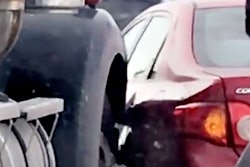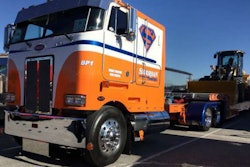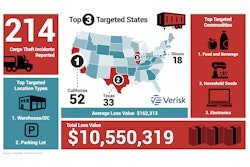
Women who are professional truck drivers have some strong opinions about regulations dictating how they can use their trucks for personal reasons.
The Federal Motor Carrier Safety Administration recently released a proposal to slightly alter the guidance issued to carriers and drivers involving the use of their truck as a personal vehicle to drive to their home or to restaurants and motels along their route. The guidance, though related to hours of service regs in general and not specifically the use of electronic logging devices, stems from questions surrounding the use of trucks as personal conveyance vehicles that have arisen as the ELD mandate put more focus on the special driving category.
You can make comments online until Jan. 18.
The key change to the personal conveyance guidance is the removal of the requirement that trucks be unladen to be used for personal conveyance. FMCSA says the change is mostly meant to allow straight truck drivers the opportunity to use their truck, even if it is laden with work- or load-related materials or tools, for personal use.
Here’s a few of the comments made by women:
Debra Miller: I would like to be able to not disconnect while under a load as sometimes it can be difficult or dangerous. As long as I show leaving and then returning to parking spot/ location, it should not be an issue.
Susan Lockhart: The purpose of the HOS rules are to prevent fatigue and prevent accidents and is comparable to general overtime regulations imposed for similar reasons. However, I am of the opinion if a driver is not operating any motor vehicle while “in commerce” they should not be held to the HOS standards. An owner/operator should be allowed to drive his/her vehicle as they would any other vehicle on the road during their off duty time; and if a company allows an employee to use their company issued vehicle for personal use, that should be between the company and their insurance provider; but neither should fall under hours of service regulations as it’s preventing and not enhancing the welfare of the driver during their personal time. The original intent of HOS was to regulate just that — the hours a driver is “working” or “hours of service.” If a vehicle, any vehicle, is to be restricted for personal use then the vehicle itself should be restricted not for “non-commercial use” and not the individual operating it. I’m sure the opposing argument would be “what if it’s being used in commerce and not being recorded?” It’s a fair rebuttal that review of bills of lading and paychecks could easily identify fraudulent “personal conveyance” use of a commercial vehicle. An alternate suggestion to personal conveyance restrictions would be to develop a rule and significant fine for “failure to document commercial use of a vehicle” as it would be both fraud and false documentation.
Stacie Perry: Since I was a child I dreamed of owning my own truck. A few years ago I achieved that goal. I love trucking so much I gave up my life at home to do what I love — drive this truck. See I go home about two months out of a year. A week here and there never for very long since my family and friends all work all week there’s not much to do by yourself. So I don’t own a car. It makes no sense to me when I don’t stay home long enough. I schedule doctors appointment and go everywhere else you go in your car; laundromat, grocery store, you name it, I take my truck. So you see I need to be able to use my truck to do all these things. I live in a country town that has no public transportation. One of my doctors is 40 miles from my home. You have already taken away my Fourth Amendment rights by insisting I buy and install a ELD, something I don’t have to have. Paper works fine for me. And, by the way, I’ve never forgotten how many hours I have and can legally drive as the Qualcomm add says.
Claudia Carlisle: I too use my truck for personal use. I deliver 165 miles from home and so I sometimes bobtail or bring an empty trailer back. I take a load back up and log that as on duty driving. If I’m not under a load I’m off duty as far as I’m concerned. Of course as other drivers have stated, sometimes we need to get groceries and the like. Personally, I don’t eat truck stop food so I sometimes have to go shopping. What are we supposed to use when we are not working? I’m so tired of the government telling us when and how we are supposed to do our job! Next you will be telling us when we can sleep, eat, poop, shower. Oh, wait … you already do. I’m so ready to sell my truck and move on to something else in life.
Kimberley Douglas: All drivers should be able to operate a laden CMV as a personal conveyance within a specified amount of miles. There is not enough safe parking for truckers so why not allow them to be able to make it home, to a truck stop, rest area, etc. or go to get some food.
Janet Eason: Service hour clock is dangerous and silly. I have to drive even if I’m tired so I can keep my schedule, and I have to stop for a 30-minute or 10-hour break even if I’m five minutes away from my destination. We need more freedom to drive according to our needs. I understand the goal of the clock but the method to achieve the goal is ineffective and counter productive.
Sara Noe: The guidance modification is a welcomed change, to a point. As a motor carrier there are times when a driver may need to operate a laden vehicle in a personal conveyance manner and the stipulation that the vehicle be unladen was an extra step that may cause additional issues. For example, currently a driver parked in a truck stop must be unladen in order to physically move his tractor and have it not recorded as on-duty driving time. A driver moving his vehicle in a truck stop for any reason (perhaps to get a better parking spot, away from a loud reefer running all night, or a cattle hauler with noisy animals or to get closer to take a shower, eat, etc.) should be able to be personal conveyance (but under the current rules if a driver is laden, then that cannot occur.) The driver is certainly free to drop their trailer and then use the PC exemption, however that causes issues with locations allowing dropped trailers, theft of trailers and in inclement weather being unable to reattach to the trailer for any number of reasons. This same situation would be if a driver chose to take their break in a location that at some point became unavailable for them to remain in such as a shipper/receiver makes them leave their yard; the driver attempts to go to a truck stop but due to overcrowding (a very big problem these days) the driver must find another location to take their break. I would request additional clarification/modification on the addition of b (3) particularly the inability for a driver to use the PC exemption when they are empty, headed back to their home terminal. In previously-worded guidance and/or regulation, there was no mention that a driver who was empty could not use the PC exemption to go to their home terminal. If a driver has been relieved of their duties, and they are unladen and are headed back to their home terminal (say to take their 34 hour reset) we would request the PC exemption be made available to them. I would agree that if the driver was laden, then the PC exemption need not be an exception they may take. Proposed modified wording would be, “A driver may use the Personal Conveyance exemption when operating an unladen vehicle in order to reach a location designated or authorized by the carrier for parking or storage of the CMV, such as a permanent residence, authorized lodging, or home terminal up to 100 route miles (versus air miles) from the point of first utilizing the Personal Conveyance exemption, for the sole purpose of attaining the driver’s 34 Hour Reset.” This would allow drivers, essentially “coming home empty” to use Personal Conveyance to get them home and get a proper rest at home, which is of far greater value than the rest they receive on the road.











